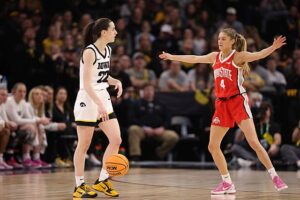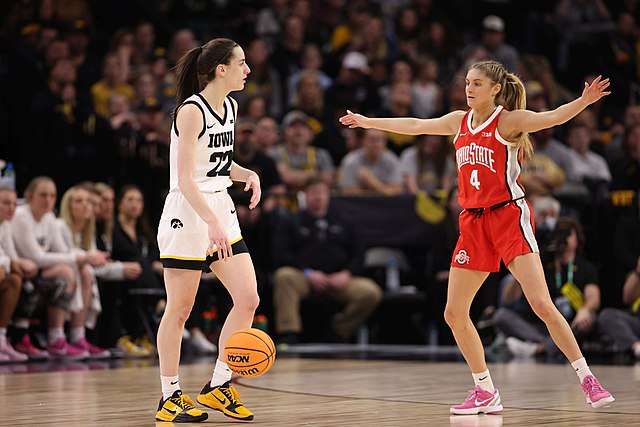The National Collegiate Athletics Association (NCAA) hosts a tournament for the top 68 women’s and men’s teams in Division I basketball every year, beginning mid-March. This tournament is commonly known as March Madness, as powerhouse teams are taken down by the underdogs in this single-round elimination tournament. While some of these wins may be due to luck, the unpredictable game outcomes are also a result of the lack of human input that goes into seedings and unique coaching strategies.
A team is seeded based on their performance and game outcomes in the regular season, organizing the bracket so that the best teams in the tournament have easier matchups in the earlier rounds. For example, the one-seed plays the 16-seed in the first round, the two-seed plays the 15-seed, and so on. In March Madness, there are four of each number seed—one for each location-based quadrant of the bracket (South, Midwest, East, and West). There is also an overall one-seed on both the men’s and women’s side, with Houston and South Carolina earning that placement respectively for this year’s tournaments.
Prior to the beginning of the NCAA tournament, FiveThirtyEight predicted that South Carolina had a 64% chance of winning the entire championship on the women’s side and that Houston had a 22% chance of winning on the men’s side. Yet South Carolina lost the Final Four (semifinal) game that they had a 80% chance of winning to the two-seed Iowa team that had a 20% chance, and Houston lost the Sweet Sixteen (quarterfinal) game that they had a 79% chance of winning to a five-seed Miami team that had a 21% chance. March truly is a month of madness in the NCAA Division I Collegiate Basketball Tournament.
March Madness seedings are determined by a number of factors, including plenty of data-based analysis. However, the seedings used to be determined by a committee that would watch all of the games, confer and then hand-pick the seedings. While these data-driven seedings are theoretically more accurate, they don’t account for style of play, individual matchups or encapsulate all of the detail that a human watching collegiate games might pick up on.
Dave Flemming is an Entertainment and Sports Programming Network (ESPN) commentator on baseball and college basketball. He described how the seedings failed to predict the outcome of the Iowa vs South Carolina matchup on the women’s side in the Final Four: “It may have said that South Carolina had a high chance of beating Iowa based on the stats, but if you watched the teams through the season, it would be clear that it’s closer to a 50-50 matchup.” South Carolina technically should have had an advantage in this game, yet Iowa won 77-73 led by Caitlin Clark with 41 points. In contrast, Iowa held South Carolina’s star player, Aliyah Boston, to single digits that game.

photo courtesy of Wikimedia Commons
The women’s tournament had an unprecedented increase in viewership this year, potentially as a result of talent disparities among NCAA D1 Women’s Basketball teams becoming less prominent. In fact, the Iowa vs Louisville Elite Eight game averaged 2.5 million viewers, peaking at 2.7 million — a number higher than that of any NBA telecast on ESPN during the regular season this year. Flemming attributed this fact to a higher quality of play and dedication to the sport going back to girls playing at the high school level.
“The sport has never been more popular, more kids are playing, there are more good players, and so the top teams can’t hoard all of the talent like they used to. I think soon we will view the women’s tournament just like the men’s – we will expect upsets and chaos starting right away. That never used to be the case,” Flemming said.
The level of competition that Clark brought to the game of women’s basketball this year was revolutionary, becoming the first player in NCAA history to achieve a 40+ point triple-double (10+ points, rebounds, and assists) in a tournament game. While in previous years the women’s tournament had a regular set of teams that did well in the tournament, including South Carolina, Stanford, Louisville, Connecticut and more, this year almost every team in the tournament proved their grit and that they truly deserved to be there.
On the other hand, Flemming attributes the inaccuracies of seedings on the men’s side to a different issue: “I think on the men’s side this was simply a year where there were no great teams. Or maybe one — UConn — that was undervalued going into the tournament. So the top seeds were unusually vulnerable this year,” he said.
Going into the tournament, the Connecticut men’s team was a four-seed with only a 3% chance of winning the entire tournament. Yet they breezed through every single game, winning the championship against San Diego State by 17 points. Connecticut’s closest game in the tournament was against Miami in the Final Four, a game they still won by 13 points. The overall one-seed of the tournament, Houston, got knocked off by the same Miami team in the Sweet Sixteen by 14 points.
Flemming noted that some of the most common upsets in the NCAA tournament are four vs 13 seed matchups and five vs 12 seed matchups. “By the seeding lines, [the higher seeded] teams are big favorites and there is a lot of pressure to win. But very rarely is the talent difference that great. Evenly matched games are portrayed as lopsided, putting a ton of pressure on the favored teams,” Flemming said. The pressure and expectations placed on teams based on seedings can have a very real impact on the outcome of the game. In this year’s tournament, an example of this was four-seed Virginia’s defeat to 13-seed Furman in the first round of the men’s tournament.
Antonia Casey ’23 hosted a men’s bracket with many Lick-Wilmerding High School student participants. She also has a bracket pool with her family every year, winning over $800 last year. She described the accuracy of her brackets this year compared to others: “I did really aggressively mediocre in my Lick-Wilmerding bracket this year. There were a lot of upsets I didn’t get,” she said. “They don’t call it March Predictable.”

photo courtesy of Wikimedia Commons
Olivia Richardson-Feldman ’25 participated in a women’s bracket hosted by LWHS Body Mind Education teacher and Girls’ Varsity Basketball Coach Daniel Tesfai. Richardson-Feldman came in second place this year. “I felt like I was pretty successful with my bracket this year. There were lots of upsets, especially with Indiana, a one-seed, losing so early. But, you know, I just had to believe in LSU,” she said. She had predicted Louisiana State (LSU) losing in the finals to South Carolina.
“I think that there were more upsets this year because more women’s programs are becoming stronger than in the past, so I think the consistent betting on UConn and other schools like that didn’t work this year, proving that there are other universities that can have strong women’s programs,” Richardson-Feldman said.
“I don’t think there were really more upsets on the men’s side, but they definitely were upsetting to me. One thing that was funny was that two people who knew absolutely nothing about college basketball ended up leading my bracket for a long time,” Casey said.
One of the biggest upsets of the entire men’s tournament was the first round game between Purdue, a one-seed with a historically successful performance record in the tournament, and Fairleigh Dickinson (FDU). A day after FDU’s shocking win over Purdue 63-58, the New York Times published an article about a “formula” that FDU adapted from a nearby Division II school to pull off the upset.
FDU is the shortest team in men’s DI basketball. Instead of focusing their efforts on guarding Purdue’s 7’4” center Zach Edey, FDU shut down the rest of his teammates and forced Edey to work alone, preventing Purdue from working cohesively as a unit. FDU used their smaller size to their advantage, playing at a fast pace for the entire game.
While not every school has a “formula” to success against powerhouse teams, the coaching has made a large impact on the outcomes of March Madness games and the underdogs pulling off an upset. In only her third year as the women’s head coach at Louisiana State, Kim Mulkey pulled off a national championship with an almost entirely new team of freshmen and transfers, including star player Angel Reese. Prior to coming to LSU, Mulkey won the tournament with the Baylor women’s basketball program three times since 2005.
South Carolina women’s basketball coach Dawn Staley also had a huge impact on the team’s success, leading them to a 42-game win streak across more than a year between last year’s championship and their loss to Iowa this year. “Dawn Staley does this with size and rebounding — just crush your opponent on the offensive glass and make sure you shoot way more shots than the team you are playing,” Flemming said.
Flemming also pointed out Rick Pitino’s unparalleled success in tournament games coaching the Kentucky men’s team in the past. “He realized that every team — even great ones — can have a bad shooting game. So how do you protect against that? Press the heck out of your opponent, create a ton of turnovers, and have more possessions and more shots. So even if you shoot poorly you can win.”
As Casey said, they don’t call it March Predictable for a reason. The women’s NCAA tournament is coming to a time where the playing field among all D1 universities is leveling out, as demonstrated by Stanford’s loss to Washington in the regular season. Stanford is typically a powerhouse team and had several experienced players this year, yet a Washington team that did not even make the NCAA tournament was able to defeat them during the regular season. In future years, maybe a sixteen-seed like the men’s FDU team will win it all — after all, the month of March is full of madness.







